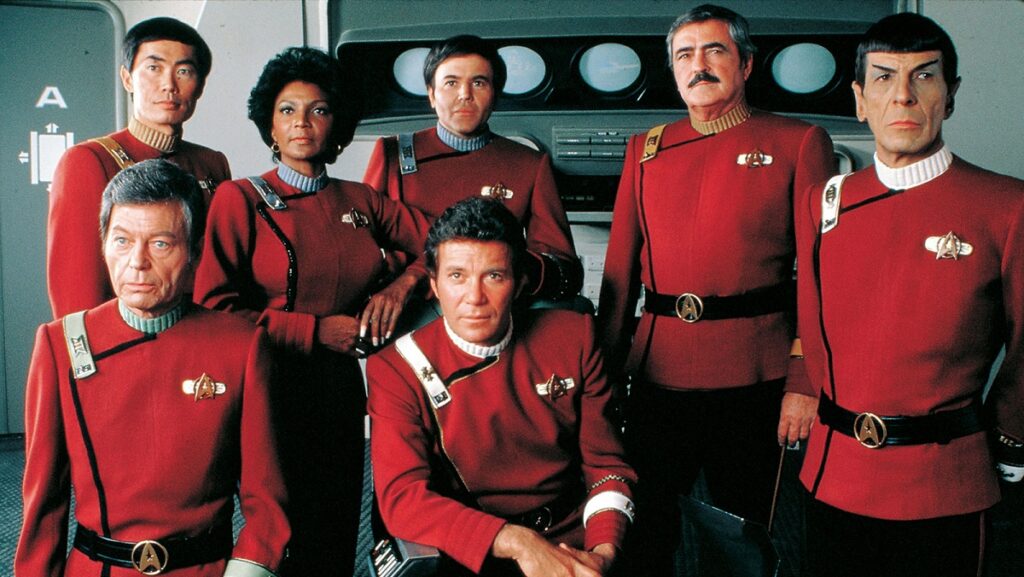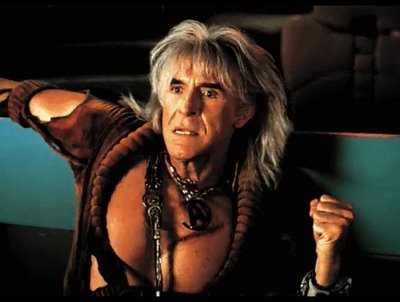Star Trek II: The Wrath of Khan (1982)

DIRECTOR: Nicholas Meyer
CAST:
William Shatner, Leonard Nimoy, DeForest Kelley, James Doohan, Walter Koenig, George Takei, Nichelle Nichols, Ricardo Montalban, Kirstie Alley, Bibi Besch, Merritt Buttrick, Paul Winfield
REVIEW:
WARNING: This review discusses details of the film’s plot.
After the sluggish and pretentious special effects/philosophical showcase of the highly-anticipated but disappointingly-received Star Trek: The Motion Picture, the powers-that-be returned Star Trek to the roots that had made the original television series so popular: a focus on the characters, and ship-to-ship duels that harkened back to what creator Gene Rodenberry himself had likened to “Horatio Hornblower in space”. The result has various dated elements, but remains worthy of its place as one of the better feature films featuring the original Enterprise cast.
We pick up sometime after the previous series and feature film. James T. Kirk (William Shatner), now an Admiral, is resigned to an administrative position, leaving Spock (Leonard Nimoy) as captain of the Enterprise, whose crew includes a lot of fresh cadets, including Spock’s by-the-book half-Vulcan protege Saavik (Kirstie Alley), along with familiar faces like Dr. “Bones” McCoy (DeForest Kelley). Chekov (Walter Koenig) is serving on another ship, the Relient, under Captain Tyrell (Paul Winfield), on the way to inspecting a barren planet to determine its suitability for the test of a new device, the Genesis project, devised by Kirk’s ex, Dr. Carol Marcus (Bibi Besch), to create ‘life from nothing’. If used on a deserted planet, Genesis will create a flourishing ecosystem, but in the wrong hands, it could be used to wipe out existing life in favor of its new creation. It is here that Chekov and Tyrell run into an old enemy, Khan (Ricardo Montalban), a criminal marooned there by Kirk fifteen years earlier, who has been simmering for revenge ever since. Khan hijacks the Relient to steal the Genesis device and wreak his vengeance on Kirk.
The Wrath of Khan is Star Trek brought back to the basics, a a seemingly simple story of space duels and high adventure, with a little philosophical meat on its bones along the way. The debate between Spock and McCoy over whether Genesis is dangerously playing God is interesting, and Khan could be viewed as a man more warped and twisted by personal suffering and consumed by his obsession with vengeance than inherently evil. He and Kirk are both men of sizable egos and indomitable wills, who refuse to accept defeat even when it’s staring them in the face. Kirk himself is going through a midlife crisis, depressed about his glory days as the heroic captain of the Enterprise receding into the past and feeling like he’s turning into one of the relics in his antique collection. This touch of vulnerability and character detail makes Kirk a more interesting and relatable protagonist than the cocky hero we’re used to seeing him as.
The Wrath of Khan‘s reach sometimes exceeds its grasp. While the story it tells is a pretty simple one of personal vengeance and old scores to settle, the visual effects are badly dated by today’s standards. Of course it isn’t fair to hold it up against modern effects, but even in comparison to some other films of the ’80s (such as the Star Wars series), the effects look poor and old. The two biggest effects sequences, the Genesis cave (represented with a matte painting) and a cat-and-mouse pursuit through a stormy nebula, are the clearest examples of the filmmakers’ imaginations exceeding what special effects were able to effectively convey at the time. The good news is that The Wrath of Khan has the good sense to recognize that the friendship between Kirk, Spock, and Bones, and the contest between Kirk and Khan, is the core of the movie, and the effects exist to serve the story without being the point of it, making their deficiencies easier to overlook. A more irksome problem is the questionable acting abilities of most of the smaller roles, but the most famous scene of the movie (you know what I’m referring to) can still generate tears decades later. This is where the core of The Wrath of Khan lies, and in comparison, its flaws fall by the wayside.
William Shatner has never been regarded as a great thespian, and his performance is uneven, but overall this is one of his best outings in his most iconic role, aided by a script that grants Kirk a surprising level of vulnerability and makes him a more three-dimensional figure. The infamy of his hilariously overwrought scream of ‘KHAAAANNNN!!!’ that has provided endless fodder for YouTube parodies is counterbalanced by his choked-up eulogy at Spock’s funeral, where he manages to muster more emotion than some might have thought him capable of. In fact, his eulogy for Spock may very well be the strongest acting moment of Shatner’s career. The rest of the Enterprise crew is what we expect of them, with Nimoy and Kelley the strongest actors. Of the “guest stars”, Kirstie Alley makes some impression as the anal, vaguely sexy Saavik, but while Bibi Besch is adequate as Carol Marcus, Merritt Buttrick is flat and wooden as David, making the whole “Kirk’s unknown son” subplot lack an impact. Of course, the biggest guest star is Ricardo Montalban, reprising his role from an episode of the original series as the Captain Ahab-esque Khan. Montalban’s is the most entertaining performance in the movie, mostly because it’s so hammy, with his wild-eyed glares and snarling line delivery. Montalban plays the role for all it’s worth, overacting shamelessly, and his scenery-chewing won him a place in the top ranks of Trek villains which he has comfortably held ever since.
The Wrath of Khan is essential viewing for any fan of the Trek series, and one of the most mainstream crowd-pleasing entries even for those who are not. The combination of high space adventure, personal vendettas, and a final note of genuinely affecting tragedy make it one of the best sci-fi adventure films of the 1980s, and decades later, despite dated effects and acting, its core remains intact.
***

